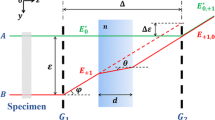Abstract
A novel experimental technique is presented that combines the optical method of caustics and the full-field lateral shearing interferometer of coherent gradient sensing (CGS) in one setup. Collimated light transmitted through a deformed specimen is separated into two legs. One is processed by the lateral shearing interferometer and is recombined with the other on a single image plane. By adjusting the optical path length of each leg, a combination lateral shearing interferogram/caustic image is generated. When this technique is applied to a fracture specimen, information about the stress intensity factor can be obtained from the caustic and the CGS interference fringes for exactly the same deformation field. This allows for a direct comparison between the two methods when investigating phenomena such asK-dominance, three-dimensional deformation and so on. In this paper, the technique is presented in detail, and its feasibility is tested by application to mode I and mixed-mode crack tip deformation fields.
Similar content being viewed by others
References
Manogg, P., “Anwendung der Schattenoptik zur Untersuchung des Zerreissvorgangs von Platten,” Doctoral diss., Freiburg, Germany (1964).
Theocaris, P.S. andJoakimides, N., “Some Properties of Generalized Epicycloids Applied to Fracture Mechanics,”J. Appl. Mech.,22,876–890 (1971).
Rosakis, A.J., Duffy, J., andFreund, L.B., “The Determination of Dynamic Fracture Toughness of AISI 4340 Steel by the Shadow Spot Method,”J. Mech. Phys. Solids,32,443–460 (1984).
Rosakis, A.J. andRavi-Chandar, K., “On Crack-tip Stress State: An Experimental Technique for Evaluation of Three-dimensional Effects,”Int. J. Solids Struct.,22, (2)121–134 (1986).
Kalthoff, J.F., Shadow Optical Method of Caustics, “Handbook on Experimental Mechanics,”ed. A.S. Kobayashi, Prentice Hall, Englewood Cliffs, NJ, 430–500 (1987).
Sanford, R.J. andDally, J.W., “General-method for Determining Mixed-mode Stress Intensity Factors from Isochromatic Fringe Pattern,”Eng. Fract. Mech.,11,621–633 (1979).
Burger, C.P., “Photelasticity,”Handbook on Experimental Mechanics, ed. A.S. Kobayashi, Prentice Hall, Englewood Cliffs, NJ, 162–281 (1987).
Epstein, J.S. andDadkah, M.S., “Moiré Interferometry in Fracture Research,”Experimental Techniques in Fracture, ed. J.S. Epstein, VCH, New York, 427–508 (1993).
Williams, M.L., “On the Stress Distribution at the Base of a Stationary Crack,”J. Appl. Mech.,24,109–114 (1959).
Krishnaswamy, S. andRosakis, A.J., “On the Extent of Dominance of Asymptotic Elastodynamic Crack-tip Fields: I. An Experimental Study Using Bifocal Caustics,”J. Appl. Mech.,58, (1)87–94 (1991).
Rosakis, A.J., Krishnaswamy, S., andTippur, H.V., “On the Application of the Optical Method of Caustics to the Investigation of Transient Elastodynamic Crack Problems: Limitations of the Classical Interpretation,”Optics Lasers Eng.,13,183–210 (1990).
Tippur, H.V., Krishnaswamy, S., andRosakis, A.J., “A Coherent Gradient Sensor for Crack Tip Deformation Measurement: Analysis and Experimental Results,”Int. J. Fract.,48,193–204 (1991).
Lee, H. andKrishnaswamy, H., “A Compact Polariscope/Shearing Interferometer for Mapping Stress Fields in Bimaterial Systems,”Experimental Mechanics,36,404–411 (1995).
Tippur, H.V., Krishnaswamy, S., andRosakis, A.J., “Optical Mapping of Crack Tip Deformations Using the Methods of Transmission and Reflection Coherent Gradient Sensing: A Study of Crack Tip K-dominance,”Int. J. Fract.,52,91–117 (1991).
Prabhu, S., “Three Dimensional and K-dominance Effects in Isotropic and Anisotropic Cracked Solids,” Doctoral diss., Department of Mechanical Engineering, University of Delaware (2000).
Prabhu, S. andLambros, J., “Effect of Mode Mixity on K-dominance and Three Dimensionality in Cracked Plates,”Int. J. Fract.,104,51–69 (2000).
Author information
Authors and Affiliations
Rights and permissions
About this article
Cite this article
Prabhu, S., Lambros, J. A combination optical method of lateral shearing interferometry and caustics. Experimental Mechanics 40, 376–383 (2000). https://doi.org/10.1007/BF02326483
Received:
Revised:
Issue Date:
DOI: https://doi.org/10.1007/BF02326483




